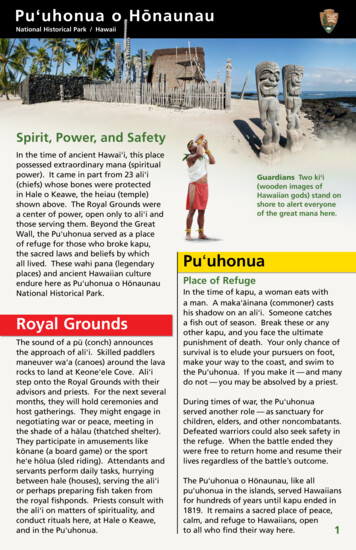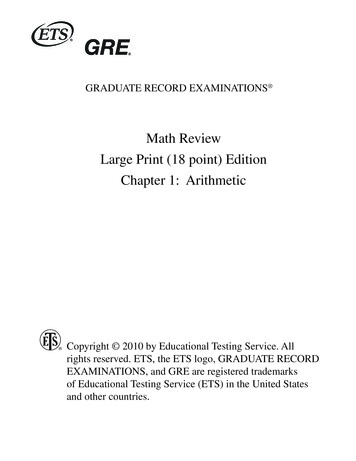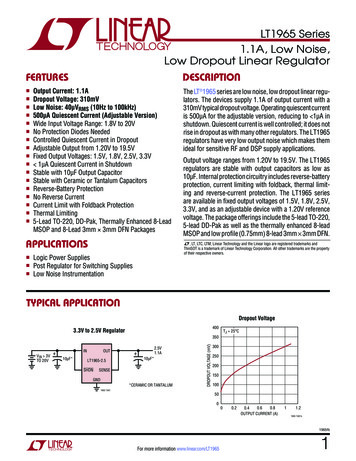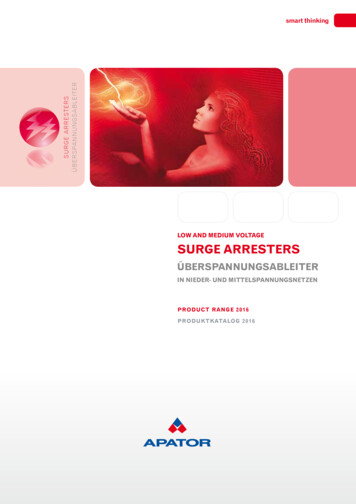
Transcription
Pu‘uhonua o HönaunauNational Historical Park / HawaiiSpirit, Power, and SafetyIn the time of ancient Hawai‘i, this placepossessed extraordinary mana (spiritualpower). It came in part from 23 ali‘i(chiefs) whose bones were protectedin Hale o Keawe, the heiau (temple)shown above. The Royal Grounds werea center of power, open only to ali‘i andthose serving them. Beyond the GreatWall, the Pu‘uhonua served as a placeof refuge for those who broke kapu,the sacred laws and beliefs by whichall lived. These wahi pana (legendaryplaces) and ancient Hawaiian cultureendure here as Pu‘uhonua o HönaunauNational Historical Park.Royal GroundsThe sound of a pū (conch) announcesthe approach of ali‘i. Skilled paddlersmaneuver wa‘a (canoes) around the lavarocks to land at Keone‘ele Cove. Ali‘istep onto the Royal Grounds with theiradvisors and priests. For the next severalmonths, they will hold ceremonies andhost gatherings. They might engage innegotiating war or peace, meeting inthe shade of a hälau (thatched shelter).They participate in amusements likekönane (a board game) or the sporthe‘e hölua (sled riding). Attendants andservants perform daily tasks, hurryingbetween hale (houses), serving the ali‘ior perhaps preparing fish taken fromthe royal fishponds. Priests consult withthe ali‘i on matters of spirituality, andconduct rituals here, at Hale o Keawe,and in the Pu‘uhonua.Guardians Two ki‘i(wooden images ofHawaiian gods) stand onshore to alert everyoneof the great mana here.Pu‘uhonuaPlace of RefugeIn the time of kapu, a woman eats witha man. A maka‘äinana (commoner) castshis shadow on an ali‘i. Someone catchesa fish out of season. Break these or anyother kapu, and you face the ultimatepunishment of death. Your only chance ofsurvival is to elude your pursuers on foot,make your way to the coast, and swim tothe Pu‘uhonua. If you make it — and manydo not — you may be absolved by a priest.During times of war, the Pu‘uhonuaserved another role — as sanctuary forchildren, elders, and other noncombatants.Defeated warriors could also seek safety inthe refuge. When the battle ended theywere free to return home and resume theirlives regardless of the battle’s outcome.The Pu‘uhonua o Hönaunau, like allpu‘uhonua in the islands, served Hawaiiansfor hundreds of years until kapu ended in1819. It remains a sacred place of peace,calm, and refuge to Hawaiians, opento all who find their way here.11
KĪPAIPAI ‘IA I KA ‘OIA‘I‘OBecome Inspiredby the AuthenticToday the Hale o Keawe,Pu‘uhonua o Hōnaunau, RoyalGrounds, and surroundinglands remain a center oftraditional Hawaiian life.This long tradition has beenperpetuated by the NationalPark Service since 1961. At thepark’s cultural festival, heldevery summer, you can becomeimmersed in Hawaiian culture.Hawaiians maintain ancienttraditions today. A girlmakes kapa (below).A man carves wood(bottom left). A manprepares to gather fishwith a net (below right).2A woman chants andbeats a drum to lead ayoung dancer in hula.
Exploring Through Time900 – 1100 CE (Common Era)1779 – 1810Polynesians arrive in the Hawaiian islands,likely from the Marquesas Islands 2400miles south. Their voyaging canoes carryplants, animals, and supplies needed tolive here. People settle in hereditarygroups led by a chief. Their farming,hunting, and gathering begin to changethe land.In 1779, English explorer Captain JamesCook sails into Kealakekua Bay, northof Hōnaunau. His is the first recordedcontact with Hawaiians on this island. In1782, Kalaniopu‘u dies. Kamehamehadefeats his rivals and rises to power. Heunifies the Hawaiian islands by 1810through treaty and conquest.1100 – 14001819Tradition tells of ali‘i (chiefs) voyagingback and forth between Hawaii andancestral Kahiki (eastern Polynesiaand Tahiti). They bring new ideas andtraditions like temple drums, woodenimages, and ritual human sacrifice.Tradition also says voyaging ends by 1400.Afterward, Hawaiians live in isolation forseveral hundred years.Kamehameha dies. During the mourningperiod, two of his wives — Ka‘ahumanuand Keōpūolani — and his son Liholiho(Kamehameha II) defy kapu by eatingtogether. Their action begins the collapseof the kapu system. More profoundchanges in Hawaiian society follow asChristian missionaries arrive along withother Europeans and Americans.1400 – 1600Today, the Hawaiian story continuesto evolve through the sharing oftraditions and the work of archeologists,anthropologists, and other specialists.As the population expands, ali‘i establishland boundaries and centralize theirpower. They begin enforcing kapu(sacred laws), which separates them fromthe maka‘äinana (common people) bycontrolling all aspects of life. During thistime, people settle Hōnaunau, establisha pu‘uhonua (place of refuge), and buildthe first heiau (temple) here.Only ali‘i wore helmets and capesembellished with feathers.1600 – 1778Hawai‘i island is united under one ali‘i inthe early 1600s. Hōnaunau becomes aroyal center. Hale o Keawe heiau is builtto house the bones and mana (spiritualpower) of the ruling ali‘i, Keawe-‘Ī-kekahiali‘i-o-ka-moku. Ali‘i continue to expandtheir power and influence. In the mid1700s, Kamehameha is born. His uncleKalaniopu‘u was the ruling chief of theisland by the late 1770s.ALL PHOTOS NPS / PUHO3
Explore Two Sides of Hawaiian LifeFollow numbered posts on a half-mileself-guiding tour through the RoyalGrounds and the Pu‘uhonua.Red stops in theRoyal GroundsPicnic AreaYellow stops inthe Pu‘uhonua1 Royal Grounds Here, in ancient times,you would have seen workers pound kalo(taro), take fish from the ponds, or preparethe grounds for ali‘i. On the far side of theRoyal Grounds is the Great Wall (stop 7), theboundary of the Pu‘uhonua.Follow the sandy path to the right.2 Temple Model This structure is a smallreconstruction of Hale o Keawe, the heiau atstop 8. This model shows details of the heiau.Its frame is öhi‘a wood, the roof is thatchedwith kï leaves, and the trim is of ama‘u (fern).3 Kōnane This Hawaiian strategy game isplayed with black and white pebbles on apapamū (stone playing surface). Papamū canbe any size and are carved into a lava surface.If you would like to play kōnane, ask for rulesat the visitor center.4 Känoa These bowls, carved into rock, mayhave been used for dying kapa (bark cloth),tanning fishing nets, or pounding ‘awa root tomake a ceremonial drink.5 Tree Mold When hot lava surrounds a livingtree, moisture in the tree causes the lava toharden before it burns. Sometimes this leavestree molds like you see here. Many molds inthe park are of loulu palms. Loulu were onceabundant, but now are endangered.6 Keone‘ele This protected cove was kapu;only ali‘i could land canoes here. At times,honu (sea turtles) rest on the shore. Pleasewatch them from a distance; they areprotected by law.4Check the regulations and safety tips atthe end of this brochure before you begin.Please be respectful of this sacred site.P U “U H O N U AThe Great WallCoastal Access RoadAla KahakaiNational Historic Trail (1871 Trail)7 The Great Wall Up to 12 feet tall, 18feet wide, and over 950 feet long, this walldefines the sacred space of the Pu‘uhonua.The wall was constructed over 400 yearsago using uhau humu pohaku (dry-setmasonry)—stones fitted without mortar.8 Hale o Keawe This heiau was a royalmausoleum housing bones of 23 ali‘i,including s great-grandfather. Thesebones give the heiau immense mana.Hawaiians still revere this place andsometimes leave ho‘okupu (offerings) onthe lele (tower). The wooden images are ki‘irepresenting Hawaiian gods.9 Pu‘uhonua Imagine scrambling out ofthe waves onto the rough lava. Althoughexhausted and out of breath, now you aresafe. In a few days you will be absolved bya priest and can go home.10 Keöua Stone According to localtradition, this was a favorite resting placeof Keōua, a high chief. Holes in the lavasurrounding the base may have supported acoconut leaf canopy.
Could someone swim to safety?Coming by ocean might seemeasy—but the distance is great,the currents strong, the wavespowerful, the lava sharp.‘Äle‘ale‘a14101113912Hale o Keawe8715ROYALGROUNDS6Keone‘ele Cove3516412Visitor CenterAmphitheaterWalk back to the sandy path to continue thewalking tour.14 Old Heiau Site Long ago, another heiauwas built here. It may have been the firstheiau for the refuge. Ravaged for centuriesby ocean waves, only remnants remain. Theyare among the oldest structures in the park.11 ‘Äle‘ale‘a This may have been a principalheiau long before Hale o Keawe (stop 8).The platform was built in seven stages.After Hale o Keawe replaced this heiau, oraltradition describes ali‘i relaxing and watchinghula on the platform.The path now leads back toward the RoyalGrounds. Just before the Great Wall, you passa pond on the right. It is an anchialine (ankee-uh-line) pool, fed by a freshwater springand the ocean. The tour continues through amodern opening in the wall.12 Ka‘ahumanu Stone Legend holds thatQueen Ka‘a hu manu, a favorite wife ofKame ha me ha, swam to the Pu‘u honua afterthey quarreled. She hid under this stone,but her barking dog revealed her location.Fortunately, she and her husband reconciled.15 Royal Fish Ponds These anchialine poolsheld fish to be eaten by the ali‘i.13 Papamü Small poho (depressions) werecarved into flat lava rock to create thissurface for playing kōnane (stop 3). The skillsmastered in this game could be used in battleor other pursuits.The next stop is the large thatched shelter.16 Hālau In ancient times, this structurewould have been made of ōhi‘a wood tiedwith cord and thatched with pili grass. Todayit serves as a hälau wa‘a, or canoe house.Artisans work in the smaller hälau.5
UA OLA NO O KAI IA KAILife Comes from the SeaFrom ocean to shore, Hawaiians foundplenty to eat. They fished from canoes.To catch he‘e (right), they used lūhe‘e(above right)—a lure of shell, stone,wood, and bone. Uhu (below left) wasone of many reef fish they harvestedwith nets and spears. Along shore, theygathered delicacies like hä‘uke‘uke and‘opihi (bottom). And they prized honu(right) for its meat and beautiful shell.He‘e(octopus)lühe‘eHonu(green sea turtle)Uhu(parrotfish)Hä‘uke‘uke(sea urchin)‘Opihi(limpet)UA OLA NO O UKA IA UKALife Comes from the LandNiu(coconut palm)Food, medicine, clothing, ritual —Hawaiians had many uses for canoeplants brought by their ancestors. Niu(right) provided food, drink, and fiber forcord. Kalo (bottom left) and ‘Ulu (center)were staple foods. The stiff leaves ofhala (the tree below) were made intomats, baskets, and sails. Noni (below)was one of many medicinal plants.Noni(Indian mulberry)‘Ulu(breadfruit)6Kalo (taro),the source of poiHala(pandanus) JUPITER NIELSEN
E KOMO MAIWelcomeThe National Park Service welcomesyou to Pu‘uhonua o Hönaunau NationalHistorical Park, established in 1961. Weinvite you to explore the culture andenjoy the coastal landscape that speaks ofpeople who lived here for centuries.Getting HerePu‘uhonua o Hönaunau National Historical Park is in the South Kona district of theisland of Hawai‘i. Take Māmalahoa Highway (Hwy. 11) to Ke Ala o Keawe Road(Hwy. 160), between mileposts 103 and104. Follow Hwy. 160 to the entrance.Visitor CenterOpen daily. Information, exhibits, giftshop. Call or check the website for hours.Immerse Yourself in HawaiianCulture Walk the self-guiding tour in thisbrochure. Take the cell phone tour. Talk to people giving demonstrations. Attend a ranger program. Watch a film. Look for native plants and animals. Play a game of kōnane (tour stop 3). Children ages 3 and up can becomeJunior Rangers. Attend our annual cultural festival onthe weekend before the Fourth of July.1871 Trail to Ki‘ilae VillagePick up a trail guide at the visitor centerfor this 2.25-mile roundtrip hike thatpasses ancient and historic sites, volcanicfeatures, and ocean views. Wear sturdyshoes for walking on lava.Wildlife and PlantsFeeding, touching, and harassing wildlife— including those in water — is prohibited. Federal and state law protects threatened or endangered sea turtles, monkseals, and some plants.Regulations and SafetyHonor and respect ceremonies, protocols,and practices. Keep your distance and refrain from photographing and recording. Ask at the visitor center for otherspecial rules and regulations. Stay on the trails. Federal law protects all cultural objects. Firearms regulations and fishingguidelines are on the park website. Food is allowed only in the picnic area. Pets are allowed only in the picnic areaand on the Coastal and 1871 trails. Theymust be restrained and under control bya leash no longer than six feet. Wear sun protection; bring water.AccessibilityWe strive to make facilities, services, andprograms accessible to all. Beachwheelchairs are available at the visitorcenter. For information go to the visitorcenter, call, or check the park website.Related SitesExplore traditional Hawaiian life at otherNational Park sites on this island: KalokoHonoköhau National Historical Park,Pu‘u ko holä Heiau National Historic Site,Ala Kahakai National Historic Trail, andHawai‘i Volcanoes National Park.Pu‘uhonua HönaunauNational Historical ParkPO Box 129Hönaunau, Kona, HI 96726808-328-2326www.nps.gov/puhoFollow us on Facebook.Emergencies call 911Pu‘uhonua Hönaunau National HistoricalPark is one of over 400 parks in theNational Park System. To learn moreabout national parks, visit www.nps.gov.PREVIOUS PAGE: ALL PHOTOS—NPS / PUHO UNLESS OTHERWISE CREDITED. ILLUSTRATIONS — NPS / PHYLLIS MAGAL. PHOTO — JACK WOLFORD; OBJECTS: GARY EOFF7
National Park Servicewww.nps.gov/puhoU.S. Department of the InteriorTo Kealakekua BayH Ō N A U N A UBaywe Roado KeaAlaeKRoadHōnaunauaunauHōnMīanaPointA H U P U A ‘A160hBeacEntranceStationKeone‘eleCovHale o KeaweOverlookParkHeadquarterse‘Āle‘ale‘a HeiauVisitor CenterPU‘UHONUA(Place of Refuge)Pu‘uhonuaPointThe Great WallROYALGROUNDSPapa hōlua(sled)uaunaHōn ōluaHCoastalAccessRoadAla Kahakai National Historic Trail(1871 Trail)‘Ōma‘oHeiauCoastalPA CI F ICO CEA NeaKēōkaHōluTrailK Ē Ō K E AKeawe House SiteAlahaka Heiau‘Īlio PointAlahaka RamphaAlahaka BaykaP a liKi‘i PointLife Beyondthe RefugeA H U P U A‘AGoat PenAla‘Āhinahina PointLife extended beyond thePu‘uhonua and Royal Groundsfor both ali‘i and maka‘äinana.From the ocean to the mountaintop,Hawaiians divided the island into moku(large districts) and smaller land divisionscalled ahupua‘a. In each ahupua‘a, theyfound all they needed to thrive: access tothe sea, fertile farmland inland, forestsin the upland, and sacred land in theupper elevations. People lived eithermakai (near the ocean) or mauka (towardthe upland); some people had parcelsboth near the ocean and higher in theagricultural zones. They used a complexsystem of trails to travel within theahupua‘a. (Note: the park boundary liesone-half mile east in the Ki‘ilae Ahupua‘a,just beyond the scope of this map.)Ki‘ilaeWaterc o urseKi‘ilaeVillageKi‘ilae Bay(site)GatePu‘uhonua o HōnaunauNational Historical ParkK I ‘ I L A EA H U P U A‘ACompostingtoiletK A U L E O L ĪA H U P U A‘AMap LegendN000.25 Kilometer0.25 MileUnpaved roadInformationTrailPicnic areaAhupua‘a boundaryPHOTO — ANNE CAMPBELL STONERestroomsWheelchair accessible GPO:2018—540-232 New in 2018Printed on recycled paper.8
power). It came in part from 23 ali‘i (chiefs) whose bones were protected in Hale o Keawe, the heiau (temple) shown above. The Royal Grounds were a center of power, open only to ali‘i and those serving them. Beyond the Great Wall, the Pu‘uhonua served as a place of refuge for those who broke










